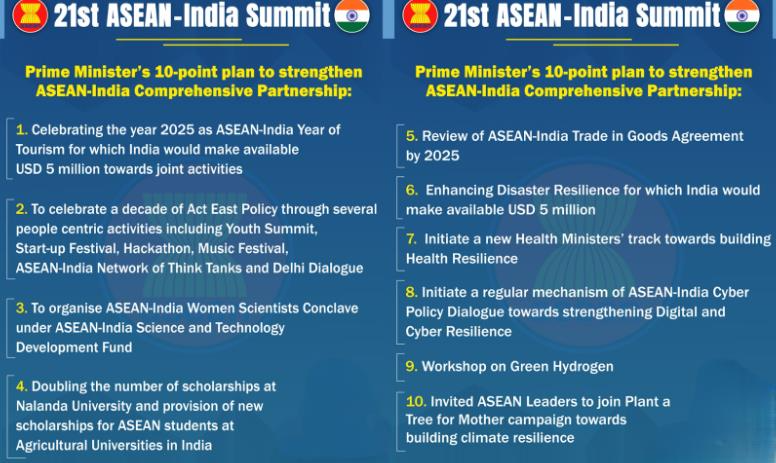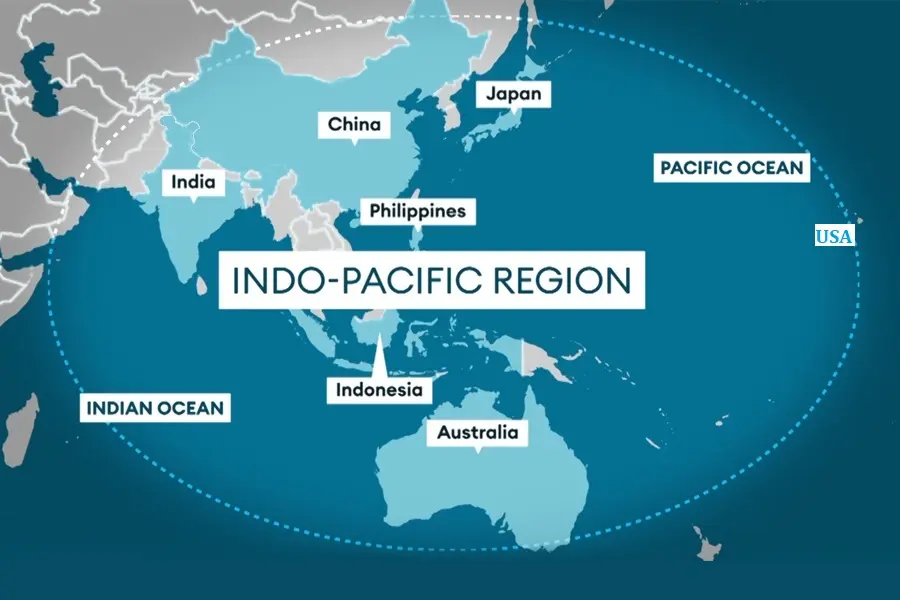International Relations
Forging a New Era of India-ASEAN Relations
- 20 Aug 2025
- 14 min read
For Prelims: Indo-Pacific region, ASEAN, Act East Policy, Free Trade Agreement, Strategic Partnership to Comprehensive Strategic Partnership
For Mains: Areas of Cooperation Between India and ASEAN, Significance of the Indo-Pacific Region for India, Key Issues Hindering India's Active Engagements in the Indo-Pacific.
Why in News?
Amid China’s growing assertiveness, the US strategic recalibration, and uncertainties in the Indo-Pacific, ASEAN’s role has become increasingly significant. For India, it remains a cornerstone of the Act East Policy and Indo-Pacific vision, as emphasized at the 2018 Shangri-La Dialogue, promoting a free, open, inclusive, and resilient Indo-Pacific.
What Opportunities does ASEAN Present to India?
- Economic and Trade Opportunities: ASEAN, with 650 million people and a GDP of USD 3.2 trillion, is a key economic and trade partner for India.
- Bilateral trade has reached USD 122.67 billion (2023–24), 11% of India’s global trade.
- Singapore is India’s largest ASEAN trade partner and 6th largest trade partner (FY 2024-25) with a share of around 3% of India’s overall trade & also the top FDI source at USD 14.94 billion.
- Full utilisation of ASEAN-India FTA (AIFTA) and finalising ASEAN-India Trade in Goods Agreement (AITIGA) can further boost trade and investment.
- Defence Cooperation: India is increasingly emerging as a reliable defense partner, providing military hardware and technology to ASEAN nations.
- Key deals, such as the sale of the BrahMos cruise missile system to the Philippines, signify a new phase of strategic cooperation.
- India's assistance also includes providing training, maintenance, and technical expertise to help modernize the armed forces of various ASEAN member states, thereby strengthening their defense capabilities and promoting self-reliance.
- Strategic & Security Engagement: ASEAN provides a strategic counterbalance amid regional tensions, reinforcing India’s Act East Policy and Indo-Pacific vision while supporting ASEAN Centrality.
- India engages through East Asia Summit and ASEAN Regional Forum, ASEAN Maritime Forum, and joint exercises like the ASEAN-India Maritime Exercise (South China Sea, 2023).
- Cooperation spans anti-piracy measures, disaster management, and promoting a rules-based regional order aligned with India’s SAGAR doctrine.
- Connectivity & Infrastructure Integration: India-Myanmar-Thailand Trilateral Highway and Kaladan Multi-Modal Transit Transport projects are poised to enhance regional physical connectivity and integration, while also boosting economic development in India’s Northeast by positioning it as a hub for regional trade.
- Digital initiatives like 5G, cybersecurity, and participation in the ASEAN Smart Cities Network (ASCN) strengthen technological and economic linkages.
- These efforts provide alternatives to China’s Belt and Road Initiative and promote economic and cultural integration in the region.
- Tech & Energy Cooperation: India-ASEAN collaboration also spans IT, fintech, e-commerce, AI, and start-ups (via ASEAN-India Start-up Festival), supported by the ASEAN-India Science & Technology Development Fund.
- Cooperation in energy resources, solar and clean technology, and semiconductors strengthens energy security and sustainability, highlighted by the ASEAN-India High-Level Renewable Energy Conference in 2022.
- Cultural & People Ties: India-ASEAN historical and cultural links support soft power through the Artists’ Camp, Music Festival, and Network of Universities (2022), enhancing academic and societal bonds.
- Participation in Initiative for ASEAN Integration Work Plan IV and centers of excellence promotes innovation, connectivity, and sustainable development.
- Year 2025 has been designated the ASEAN-India Year of Tourism, featuring youth summits, start-up festivals.
- Also, Indonesia’s Ramayana Ballet and Thailand’s Ayutthaya, called the “Ayodhya of Thailand,” reflect shared cultural heritage.
What are the Areas of Friction Between India & ASEAN?
- Trade Imbalance & RCEP Withdrawal: India’s trade deficit with ASEAN has widened sharply, rising from USD 9.66 billion (2016–17) to USD 45.2 billion (2024–25), largely due to faster import growth compared to export growth.
- To address concerns over market access, tariff asymmetry, and unfair trade practices, India is reviewing the ASEAN-India Trade in Goods Agreement (AITGA).
- Earlier, India withdrew from RCEP in 2019 to prevent a surge of Chinese goods via ASEAN markets, while efforts to renegotiate the ASEAN-India FTA have been slow and limited.
- Delays in Connectivity Projects: Projects like the IMT Trilateral Highway and KMMT Project face funding, security, and bureaucratic delays, impeding trade, investment, and people-to-people ties and affecting India’s regional credibility.
- Limited Defence Cooperation & Divergent Strategies: ASEAN’s divergent security priorities and economic dependence on China (ASEAN-China trade USD 702 billion vs ASEAN-India USD 122.67 billion, 2023–24) limit defence collaboration, as ASEAN countries are reluctant to counter China militarily or strategically due to their strong economic ties, resulting in only partial support for India’s Indo-Pacific vision.
- ASEAN countries also differ politically, with Vietnam and the Philippines supporting India’s open, inclusive Indo-Pacific vision, while Cambodia and others prefer neutrality.
- Also, India and ASEAN differ on their approach to Myanmar’s political crisis, where India maintains pragmatic ties with the junta for border and connectivity reasons, whereas ASEAN pursues diplomatic engagement via the Five-Point Consensus, causing friction.
- Digital Trade & Data Governance Challenges: Regulatory mismatches in digital trade, fintech, and data governance slow India-ASEAN collaboration.
- While ASEAN favors a liberal digital trade regime, India enforces data sovereignty under the Digital Personal Data Protection Act, 2023.
What Strategies Can India Pursue to Strengthen Ties with ASEAN and Assert Leadership in the Indo-Pacific?
- Enhance Connectivity (Physical + Digital): Expedite projects like IMT Trilateral Highway and KMMT Project to scale up maritime linkages, air corridors, and digital infrastructure.
- Implement mutual recognition agreements, interoperable digital platforms, and pilot projects with ASEAN partners, balancing India’s data sovereignty under the Digital Personal Data Protection Act, 2023 with ASEAN’s liberal digital trade regime.
- Bilateral initiatives like India–Singapore UPI linkage (2023) should be expanded to a regional digital payments architecture.
- Maritime Security & Blue Economy: India and ASEAN should deepen maritime cooperation beyond naval exercises and piracy patrols by enhancing underwater domain awareness, logistics and MRO support, and addressing non-traditional threats like terrorism, drug smuggling, and human trafficking.
- On the blue economy front, joint initiatives in marine technology, offshore renewable energy, and sustainable fisheries can combat IUU fishing and strengthen regional food security.
- Sustainability, Resilience & Development Partnerships: Deepen collaboration on climate change, renewable energy, disaster management, food security, and digital skilling.
- India can launch supply chain diversification initiatives in critical technologies and co-develop green energy corridors and sustainable agriculture models to boost regional resilience.
- Strengthening Institutional & People-Centric Engagement: Leverage platforms like East Asia Summit (EAS), ASEAN Regional Forum (ARF), ADMM-Plus to strengthen strategic dialogue.
- Integrate Quad–ASEAN cooperation, institutionalize Track-1.5 dialogues, scholarships, cultural exchanges, and bolster people-to-people ties to reinforce India’s leadership role in the Indo-Pacific.
- The designation of 2025 as the ASEAN-India Year of Tourism is an excellent opportunity to promote travel and cultural understanding.
- Integrate Quad–ASEAN cooperation, institutionalize Track-1.5 dialogues, scholarships, cultural exchanges, and bolster people-to-people ties to reinforce India’s leadership role in the Indo-Pacific.
- Space for Sustainability: India can elevate its space collaboration with ASEAN from a transactional level to a strategic partnership by spearheading a dedicated "Space for Sustainability" program.
- Building on the success of the South Asia Satellite (GSAT-9), India should extend its space diplomacy to ASEAN by launching a dedicated Regional Satellite for Sustainability.
- This mission would provide critical data for crop monitoring, tracking marine pollution, and delivering disaster alerts, bolstering India's role as a trusted and low-cost space partner in Southeast Asia.
- Building on the success of the South Asia Satellite (GSAT-9), India should extend its space diplomacy to ASEAN by launching a dedicated Regional Satellite for Sustainability.
ASEAN
- About: ASEAN (Association of Southeast Asian Nations) is a regional intergovernmental organization founded in 1967 in Bangkok, Thailand.
- It consists of 10 member countries: Indonesia, Malaysia, the Philippines, Singapore, Thailand, Brunei, Vietnam, Laos, Myanmar, and Cambodia.
- Objective: Promoting economic growth, regional stability, and cooperation among member states.
- India’s Engagement with ASEAN: India formal engagement with ASEAN started in 1992 as a Sectoral Dialogue Partner, became a Dialogue Partner in 1995.
- It was elevated to Strategic Partnership in 2012, and upgraded to Comprehensive Strategic Partnership in 2022.
Indo-Pacific Region
- The Indo-Pacific spans the Indian Ocean and western/central Pacific Ocean, hosting diverse cultures, ecosystems, and major powers such as India, China, Japan, and the US.
- It accounts for over half the world’s population, 60% of global GDP, and two-thirds of global economic growth.
- India’s vision promotes a free, open, and inclusive Indo-Pacific, advocating peaceful dispute resolution and respect for sovereignty and territorial integrity.
Conclusion
India–ASEAN relations stand as a cornerstone of Act East and Indo-Pacific vision, rooted in shared prosperity, strategic trust, and cultural connection. By deepening cooperation in connectivity, digital innovation, climate resilience, and maritime security, the partnership can evolve into a future-ready, rules-based and inclusive regional architecture.
|
Drishti Mains Question: Discuss the role of ASEAN in advancing India’s vision of a free, open, and inclusive Indo-Pacific. |
UPSC Civil Services Examination Previous Year Questions (PYQ)
Prelims
Q. With reference to “Look East Policy” of India, consider the following statements: (2011)
- India wants to establish itself as an important regional player in East Asian affairs.
- India wants to plug the vacuum created by the termination of the Cold War.
- India wants to restore the historical and cultural ties with its neighbors in Southeast and East Asia.
Which of the statements given above is/are correct?
(a) 1 only
(b) 1 and 3 only
(c) 3 only
(d) 1, 2 and 3
Ans: (d)
Mains
Q1. The new tri-nation partnership AUKUS is aimed at countering China’s ambitions in the Indo-Pacific region. Is it going to supersede the existing partnerships in the region? Discuss the strength and impact of AUKUS in the present scenario. (2021)









